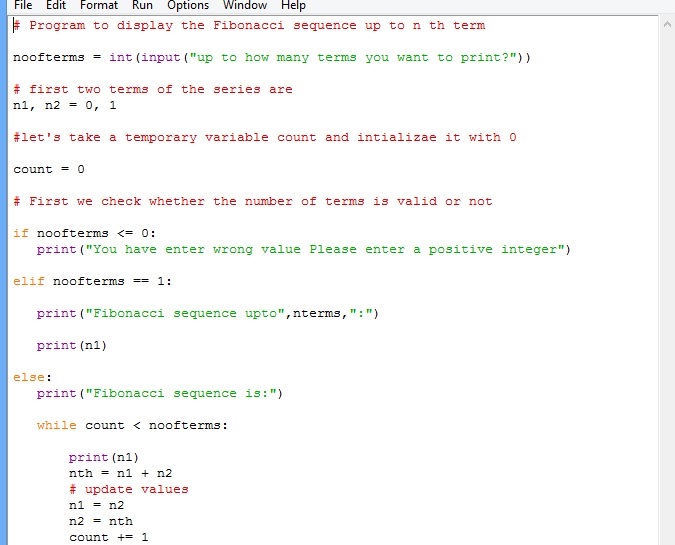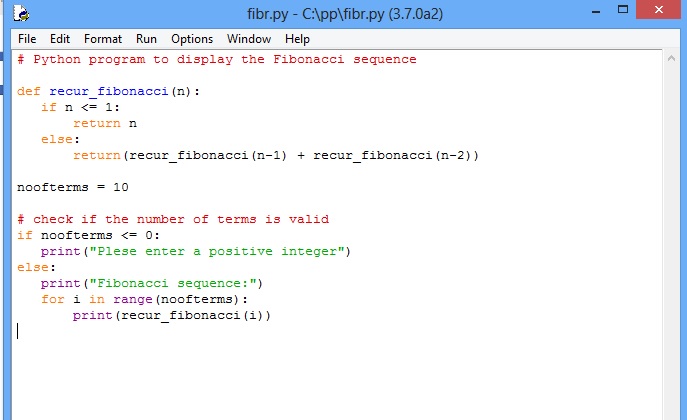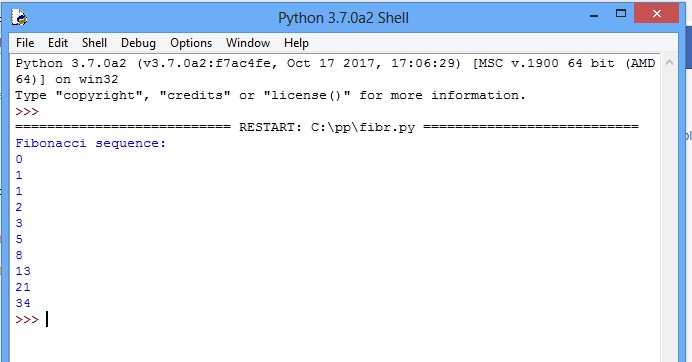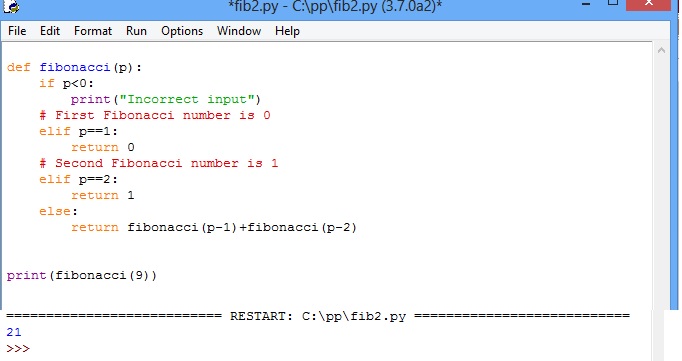Table of Contents
- 1 Fibonacci Series Implementation in Python
- 1.1 Frequently Asked Questions
- 1.2 What is the Fibonacci Series?
- 1.3 History of Fibonacci Series
- 1.4 Real-World Applications of Fibonacci Series
- 1.5 Fibonacci Day
- 1.6 Different Algorithms for Fibonacci Series
- 1.7 Recursive Algorithm for Fibonacci Series in Python
- 1.8 Fibonacci Series Program in Python using While Loop
- 1.9 Fibonacci Series in Python using Recursion
- 1.10 Python Program to find the Nth Fibonacci Number
- 1.11 Fibonacci Series Based Questions for GATE Exam
- 1.12 Conclusion and Summary
Fibonacci Series Implementation in Python
Fibonacci Series Implementation in Python
Fibonacci Series plays a vital role in the implementation of various real-world applications. We will learn the Fibonacci series’s basic concepts and implement the Fibonacci series in python in this tutorial. In this tutorial, we will also learn how to implement the Fibonacci series in python?
Fibonacci series is an essential topic for computer science engineering students from a Technical Interview point of view. Most of the companies asked to write the logic or code of the Fibonacci series in Python Programming or c programming.
This tutorial aims to provide good quality study material about the Fibonacci series and a python program to implement the Fibonacci sequence python.
This tutorial will also help students write the Fibonacci series program in python with and without Recursion.
Fibonacci series in python using Recursion in python can also be implemented using Recursion. Fibonacci series in python using while Loop also explained in this tutorial.
Frequently Asked Questions
By the end of this Fibonacci series in python tutorial, computer science students can answer the following questions
- What is Fibonacci series?
- Who is the man behind the Fibonacci series?
- What is some real-world application of the Fibonacci series?
- Give an example for the Fibonacci series in python.
- When is Fibonacci Day celebrated?
- Write the program for the Fibonacci series in python without Recursion?
- Write the program for the Fibonacci series in python with Recursion.
Let us start with the Fibonacci series introduction.
What is the Fibonacci Series?
The Fibonacci series is a widely used formula in the field of mathematics. The Fibonacci sequence python can be defined as a set of numbers that starts with either a one or a zero and follows by a one and proceeds based on a rule.
According to this ruling value of each number is equal to the sum of the preceding two numbers. This means each number in the series is the sum of the two numbers that precede it.
So as per this rule sequence will be like
0, 1, 1, 2, 3, 5, 8, 13, 21, 34 …..
The mathematical expression to calculate a term of Fibonacci can be given as
Xn+2= Xn+1 + Xn
Example of Fibonacci Series
Fibonacci sequence function is denoted by F(n) where n is the first term. The following sequence is obtained for n = 0, where the first two terms are defined as 0 and 1 by convention:
F (0) = 0, 1, 1, 2, 3, 5, 8, 13, 21, 34 …
Sometimes we use n = 1. In this situation, the first two terms will be 1 and 1 by default, and the Fibonacci sequence will be as given below
F (1) = 1, 1, 2, 3, 5, 8, 13, 21, 34 …
History of Fibonacci Series
Leonardo Pisano Bogollo was an Italian mathematician who lived from 1170 – 1250. “Fibonacci” was his nickname. The Fibonacci Sequence is named on the name of this mathematician.
Fibonacci used the arithmetic series to illustrate a problem based on a pair of breeding rabbits

Real-World Applications of Fibonacci Series
There are several applications of the fibonacci series. Some critical applications of the fibonacci series to solve the real-world problem are as follow –
- In the Agile Approach, the Fibonacci series is used to estimate the time taken to complete the task assigned to an agile team.
- Fibonacci series is also used in web development to a wight font size of the heading on the web page.
- Fibonacci series is also helpful in automobile company to convert mile into kilometre in-vehicle dashboard.
Fibonacci Day
Every year November 23rd is celebrated as Fibonacci Day. There is a logic behind this because the digits “1, 1, 2, 3” which is part of the sequence. So next Nov 23, let everyone know.
Different Algorithms for Fibonacci Series
There are following approaches or algorithm can be used to implement a Fibonacci series program
Iterative Algorithm for Fibonacci Series in Python
(1) First initialize the variables x,y to 1.
(2) Then initialize for loop in range[1,n) # n exclusive // where an is the value of the number of terms.
(3) Compute the next number in series;
total = x+y;
(4) After this, we store the previous value in y, Then store the value of total in x.
(5) Print Fibonacci series in python
Recursive Algorithm for Fibonacci Series in Python
We have also explained the code to implement the code for the Fibonacci series in python
(1) At first, we check if n equals 1 or 0;
then return 1
(2) Else
return fib(n-1) + fib(n-2)
(3) Print Fibonacci series in python
Dynamic Programming Algorithm for Fibonacci Series in Python
We can also use the Dynamic Programming algorithm to implement the Fibonacci series in python.
The following steps are used in the dynamic programming approach.
(1) Initialize an array arr of size n to zeros
(2) If n equals 0 or 1;
return 1
(3) Else
we Initialize array arr[0] and arr[1] to 1
(4) Run for loop in range[2,num]
(5) Compute the value arr[I]=arr[I-1] +arr[I-2]
(6) The array has the sequence computed till n
(7) Print Fibonacci series in python
When this algorithm, the solution would be to compute the value once and store it in an Array, and this can be accessed from this array in future if required.
Therefore, we use dynamic programming in such cases. The conditions for implementing dynamic programming are
1. overlapping sub problems
2. optimal substructure
Fibonacci Series Program in Python using While Loop
Code for fibonacci series in python it means fibonacci coding using while loop is given below. Students are advised to run this code.
# Program to display the Fibonacci sequence up to n th term
noofterms = int(input(“up to how many terms you want to print?”))
# first two terms of the series are
n1, n2 = 0, 1
#let’s take a temporary variable count and initialize it with 0
count = 0
# First we check whether the number of terms is valid or not
if noofterms <= 0:
print(“You have enter wrong value Please enter a positive integer”)
elif noofterms == 1:
print(“Fibonacci sequence upto”,nterms,”:”)
print(n1)
else:
print(“Fibonacci sequence is:”)
while count < noofterms:
print(n1)
nth = n1 + n2
# update values
n1 = n2
n2 = nth
count += 1
The snapshot of the fibonacci coding is shown in following Figure 1.

when we run the above program we get the following output as shown in following figure.
Output

Fibonacci Series in Python using Recursion
Fibonacci series in python using Recursion is given below
Here is fibonacci coding
# Python program to display the Fibonacci sequence
def recur_fibonacci(n):
if n <= 1:
return n
else:
return(recur_fibonacci(n-1) + recur_fibonacci(n-2))
noofterms = 10
# check if the number of terms is valid
if noofterms <= 0:
print(“Please enter a positive integer”)
else:
print(“Fibonacci sequence:”)
for i in range(noofterms):
print(recur_fibonacci(i))
snapshot of the above file of above program is as shown in following Figure 3.

Output of the above program is as shown in following figure.

We can also make the program by taking function.
Exercise for Students : Make a function for taking in a number and printing a fibonacci series in python.
Python Program to find the Nth Fibonacci Number
Python program to find nth fibonacci number can developed with recursion and without recursion. We will see both method.
# Following code can be used to find nth fibonacci number
def fibonacci(p):
if p<0:
print(“Incorrect input”)
# Here we are taking first Fibonacci number is 0
elif p==1:
return 0
# Here we are considering second fibonacci number is 1
elif p==2:
return 1
else:
return Fibonacci(p-1)+Fibonacci(n-2)
# Driver Program
print(Fibonacci(9))
When we run this program then we will get the out 21 as 9th fibonacci number. The snapshot for the python program and output is as shown in following picture.

Fibonacci Series Based Questions for GATE Exam
Q1. Consider the following function Fib() used to find the nth number of the fibonacci series.
Fib(n) { if(n==0) {return 0;} if(n==1) {return 1;} else { return(Fib(n-1) + Fib(n-2)); } }
Answer – Option B is the correct answer. When we use dynamic programming then every time result is calculated store it in an array but if the result is already calculated then there is no need to calculate it again therefor in worst case the complexity will be O(n).

Conclusion and Summary
In this Fibonacci series in python tutorial, we have discussed the following
- Introduction to Fibonacci Series
- History of Fibonacci Series
- Example of Fibonacci Series
- Fibonacci Series Program in Python
- Fibonacci Series Program in Python with Recursion.
- Actual world application of Fibonacci series.
I hope that this Fibonacci series in python tutorial will be helpful for computer science students in understanding the basic concepts of the Fibonacci series in python using Recursion and print Fibonacci series in python.
Your feedback is precious to us. Please give your feedback or leave a comment to improve the quality of our tutorials and provide tutorials as per your expectation.
If you find this page helpful, then please Like and Share the post on Facebook, Twitter, LinkedIn through their icons as given below.
If you want to add or contribute some more information to this tutorial, then mail us at the email id computersciencejunction@gmail.com
Do not stop learning and practice.


